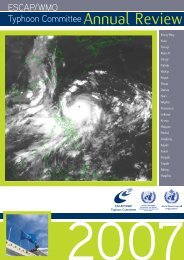TCAR - Typhoon Committee
TCAR - Typhoon Committee
TCAR - Typhoon Committee
You also want an ePaper? Increase the reach of your titles
YUMPU automatically turns print PDFs into web optimized ePapers that Google loves.
2.3 Improved <strong>Typhoon</strong>-related Disaster Risk<br />
Management in Various Sectors<br />
2.3.1 Disaster Prevention and Preparedness<br />
Achievements/Results<br />
Disaster Management Application System<br />
The Disaster Management Application System<br />
has been introduced to establish a central system<br />
for collecting, storing, processing, analyzing, and<br />
disseminating value-added data and information<br />
to support the relevant agencies in the mitigation<br />
and relief activities of disaster management in the<br />
country. It enables all government agencies to be well<br />
prepared in handling disasters as it provides important<br />
data and information about natural disasters.<br />
Beside, it also emphasizes on the utilization<br />
of remote sensing technologies, Geographical<br />
Information System (GIS) and Global Positioning<br />
System (GPS) technologies to provide up-to-date<br />
and reliable data to support the three components of<br />
disaster management, that are, (i) early warning,<br />
(ii) detection and monitoring, and (iii) mitigation<br />
and relief for pre, during and post disaster<br />
management activities coordinated by the National<br />
Security Council (NSC) and implemented by<br />
relevant authorities.<br />
“999”<br />
999 is the Dedicated Emergency Line of Customer<br />
Assistance Service (CAS) by Telekom Malaysia<br />
Berhad (TM) to improve the efficiency of public safety<br />
agencies in Malaysia. It provides reliable “on-line/<br />
real-time” information database of any or all public<br />
safety/security activities, records and/or incidents.<br />
999 Response Centre receives the call in 10 seconds,<br />
and determines correct Problem Nature and priority.<br />
The call will be transferred to the related agencies for<br />
immediate response.<br />
Guidelines for Development Projects<br />
The Department of Irrigation and Drainage and the<br />
Federal Department of Town and Country Planning<br />
produced several guidelines for development<br />
projects, namely the Urban Stormwater<br />
Management Manual (MSMA) in 2000 and Land<br />
Use Planning Appraisal For Risk Areas (LUPAr)<br />
in 2005. Local authorities in the assesment and<br />
execution of physical developments implement these<br />
guidelines.<br />
Reviewing the Directive No. 20 of the National<br />
Security Council (NSC)<br />
The National Security Council Directive No. 20 (NSC<br />
<strong>TCAR</strong><br />
CHAPTER 1 - TYPHOON COMMITTEE ACTIVITIES<br />
No. 20) or The Policy and Mechanism for National<br />
Disaster and Relief Management is the main guideline<br />
for disaster management in Malaysia. This directive<br />
prescribes the mechanism on management of<br />
disasters including the responsibilities and functions<br />
of related agencies under an integrated emergency<br />
management system. This is achieved through<br />
the establishment of The Disaster Management<br />
and Relief <strong>Committee</strong> at three different levels<br />
pending the severity of the disaster. The three<br />
levels mentioned are the federal, state and district.<br />
At the Federal level, the Minister appointed by the<br />
Prime Minister chairs this committee. The directive<br />
is supported by other Standard Operating Procedures<br />
which outline the mechanism as well as roles<br />
and responsibility of various agencies for specific<br />
disasters, such as floods, open burning, forest<br />
fire, haze, industrial disasters etc.<br />
The National Security Directive No. 20 issued by<br />
The National Security Council, Prime Minister<br />
Department encompasses the policy and mechanism<br />
on national relief and disaster assistance. Disaster<br />
management through effective coordination and<br />
integrated approach towards building a culture of<br />
prevention and civil protection is the objective of<br />
the policies and mechanisms in line with the directive.<br />
The Department of Social Welfare has 4 main tasks<br />
as stipulated in the<br />
Standard Operational Procedures (SOP) under the<br />
Directive as follows:<br />
i. Management of evacuation centers;<br />
ii. Assistance in the form of food, clothing and<br />
other necessities<br />
including family disaster kit;<br />
iii. Registration of victim; and<br />
iv. Guidance and counseling<br />
On top of that the Department of Social Welfare<br />
will also continue to assist the families who are<br />
seriously affected by disaster in order to help them<br />
to return to their normal daily life. This is considered<br />
as a long-term intervention or management process<br />
.<br />
2.3.2 Regional Cooperation Achievements/<br />
Results<br />
Regional Cooperation<br />
Malaysia was appointed as the Chairman of the ASEAN<br />
<strong>Committee</strong> on Disaster Management (ACDM) during<br />
the 11th Meeting of the ADCM on 17-29 March 2008<br />
in Kota Kinabalu, Sabah, Malaysia. The ACDM was<br />
established in early 2003 for coordinating regional<br />
cooperation in disaster management to minimise the<br />
2009<br />
79

















